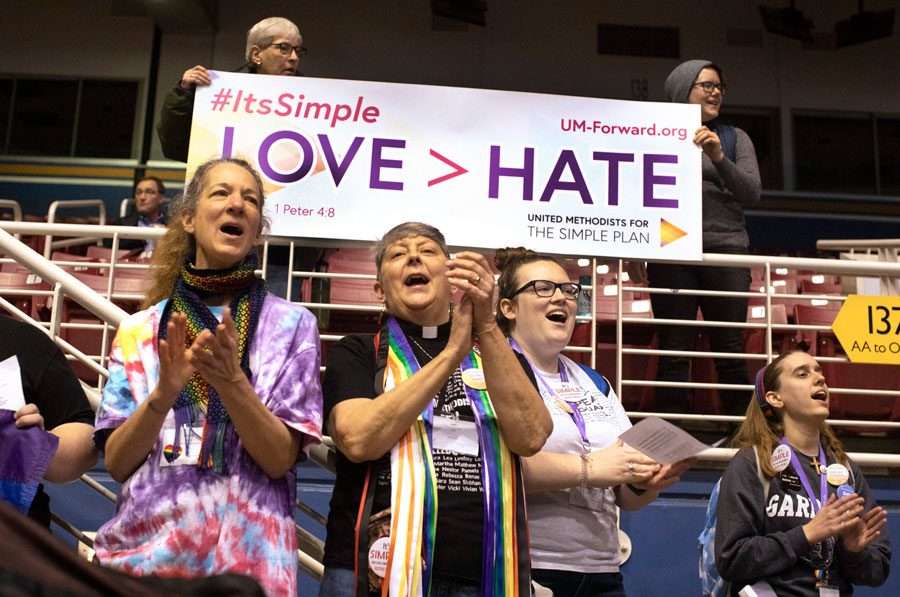After ban on LGBT-inclusive practices, progressive Methodists in Evanston see potential split of church
Photo courtesy: Kathleen Barry, United Methodist News Service
Supporters for the Simple Plan hold banners and sing at the 2019 Special Session of the United Methodist General Conference. Some local Methodists are considering a split from the Church.
May 15, 2019
Many progressive Methodists in the Evanston community are facing difficult decisions after the church strengthened bans on LGBT-inclusive practices, with some predicting a possible split.
At a special conference of the church in February, delegates of the United Methodist Church voted in favor of a plan that strengthened rules that bar the ordination of LGBTQ clergy and officiation of same-sex weddings.
The measure leaves some Methodists, such as Weinberg sophomore Katie Daehler, unsure which route to take — stay as a vocal minority within the church, or leave and reconcile the other branch’s LGBTQ policies.
It is not an easy decision, Daehler said. She finds reasons to be in both, but she falls more towards the “leave” camp.
“My faith is very much focused on welcoming all,” Daehler said. “So if that’s not what this denomination that we are currently a part of is about, then I don’t know if I belong there anymore.”
Delegates of the church from across the world convened for the 2019 Special Session of the General Conference to discuss LGBTQ inclusion in the denomination.
During the meeting, the church presented three possible plans for its future. The Traditional Plan — the most conservative of the three plans — passed 438 to 384 votes. Delegates rejected the One Church Plan, which would have given local autonomy to individual congregations and jurisdictions over LGBTQ clergy and same-sex marriage.
The Traditional Plan supporters were buoyed in large part by the 43 percent of delegates from overseas nations. Some two-thirds of American delegates — the Evanston Methodist community included — supported the One Church Plan.
Julie Windsor Mitchell, the campus minister and executive director of University Christian Ministry at Northwestern, recalled the vote as almost a “play by play,” where students consistently texted her updates about the conference. Many of her students in the University Christian Ministry are Methodist, and she said the vote came as a surprise to some.
“I guess my initial reaction was disappointment and somewhat surprised, because I actually thought the One Church Plan would pass,” Mitchell said. “I really thought, apparently mistakenly, that we would be, as a denomination, able to live under a plan where we allowed local autonomy on certain matters.”
The February session was meant to find a way forward regarding LGBTQ issues in the denomination. But now, many progressive Methodists in the Evanston community see no path ahead as a unified denomination, Mitchell said.
After the Judicial Council upheld parts of The Traditional Plan as constitutional at a meeting among Methodist leaders in Evanston last month, Mitchell said she began to hear about local Methodist pastors expressing a desire to “build something new” with progressive churches from the United Methodist Church.
“I think there will be a new way of being Methodist — kind of almost a return to Wesleyan roots,” Mitchell said in reference to the United Methodism founder John Wesley. “A Wesleyan expression that is fully inclusive and supportive of queer people in the church.”
Barry Bryant, professor of United Methodist and Wesleyan Studies at the Garrett-Evangelical Theological Seminary, said he foresees a split within the denomination as well. Instead of the church being called the United Methodist Church, Bryant suggested that they “are the ‘Untied’ Methodist Church.”
Though Bryant believes a split will occur in the near future, he does not think that a fracture would be permanent. He estimates that the church will come back together in about 25 years.
Regardless of the duration of the split, Taelor Hickey, a first-year Master of Divinity student at Garrett and observer at the General Conference, expects the division to be difficult.
“Are we going to schism? Probably,” Hickey said. “Is it going to be good or hopeful? It’s going to be messy.”
Email: [email protected]
Twitter: @zamoneperez


